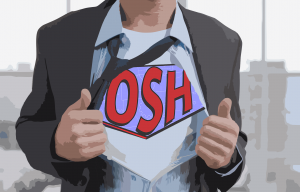The Importance of Occupational Safety and Health: Making for a “Super” Workplace
Posted on byThe scene is reminiscent of Action Comics© issue #3, the original Superman comic book series dating all the way back to 1938. In Action Comics #3, “Superman Battles Death Underground“, (issued 75 years ago this month) Superman is in the right place at the right time to save a coal miner, as well as his rescue crew, from an unsafe mine filled with toxic gas. We see instances such as these riddled throughout comic books and superhero movies. There’s always a hero around to save the day.
Unfortunately, in real life we can’t rely on the Superman – but we can rely on the many super men and women in the occupational health and safety field who are always striving to improve working conditions to keep workers out of harm’s way long before they need saving. When it comes to research, regulations, and recommendations for improving workplace safety, a lot has changed since 1938.
The Mining Industry
- Recommendations for a New Rock Dusting Standard to Prevent Coal Dust Explosions in Intake Airways
- NIOSH Hazard ID (16): Non-Conforming Rock Dust
- Coal Dust Explosibility Meter Evaluation and Recommendations for Application
- Understanding the Breathing Gas Capacities (ratings) of Escape Respirators for Mineworker Use
- SCSR Capacity

One of the goals of the NIOSH work in virtual reality is to determine the best ways to use these technologies for training and assessing the skills of mine emergency responders. In this case, responders include specially trained individuals (mine rescue or fire brigade team members), mine managers and mineworkers called upon to respond to an emergency.
To help meet this goal, NIOSH has built the Mine Rescue and Escape Training laboratory (MRET) at its Pittsburgh facility. The MRET includes a unique state-of-the-art 360° cylindrical projection system that uses stereoscopic 3D technology to enhance the immersion and experience of the users. It has the capability of putting an entire group into a virtual environment that they can interact with, providing an intuitive training experience. An adjacent 50° curved display acts as a classroom environment for instructor driven sessions and as a post-simulation debriefing environment following the sessions run in the 360° environment.
The Oil and Gas Extraction Industry
Because there are different roles in the complex oil rig environment, NIOSH has also produced two videos focusing on safety tips for those involved in rig moves, which can be one of the most dangerous parts of an oil rig operation.
Move It! Rig Move Safety for Roughnecks
One important safety precaution is as simple as wearing a seatbelt when travelling from rig to rig. Seatbelt use in this industry is low, while motor vehicle fatality rates are 8.5 that for all U.S. workers. You can learn more about NIOSH occupational safety and health efforts in the oil and gas industry by visiting the NIOSH Oil and Gas Program Portfolio.
The Commercial Fishing Industry
From 2000 to 2010, 182 fishermen died from falls overboard, none of which were wearing personal flotation devices (PFDs). Researchers from the NIOSH Alaska Pacific Office conducted a study with about 200 commercial fishermen who were asked to evaluate one of four personal flotation devices (PFDs) while working on deck. The goal was to identify wearable PFDs. By identifying PDFs that are wearable during the workday, and therefore changing the culture and attitude around wearing them, future deaths of this kind can be prevented. Putting research into practice, individual fishermen and fishing companies are changing safety policies based on research performed by the NIOSH Commercial Fishing Safety Program. For example, the Alaska Scallop Association has established a 100% PFD policy while on deck for its member boats. Certain fishing vessels of the Mariner fleet that participated in the PFD study instituted a PFD policy, purchasing the safety equipment for all crewmembers to wear while working on deck. Check out the recommendations and results from this study on the NIOSH Commercial Fishing Topic Page.
A lot has certainly changed in the 75 years that Superman has been saving lives. In that time we have better learned how to be our own heroes through safe workplace practices. Through practical research, we can work with occupational safety and health professionals in every industry to ensure a safe workplace.
Jaclyn Krah, MA; Richard L. Unger
Ms. Krah is a Health Communication Specialist in the NIOSH National Personal Protective Technology Laboratory.
Posted on by


